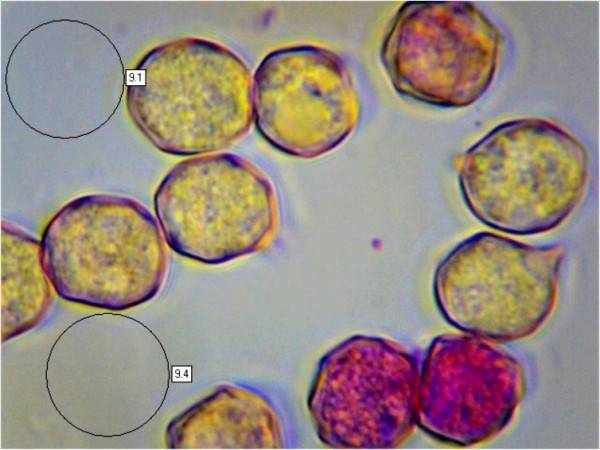Entoloma clypeatum (L.) P. Kumm. - Shield Pinkgill
Phylum: Basidiomycota - Class: Agaricomycetes - Order: Agaricales - Family: Entolomataceae
Distribution - Taxonomic History - Etymology - Identification - Culinary Notes - Reference Sources
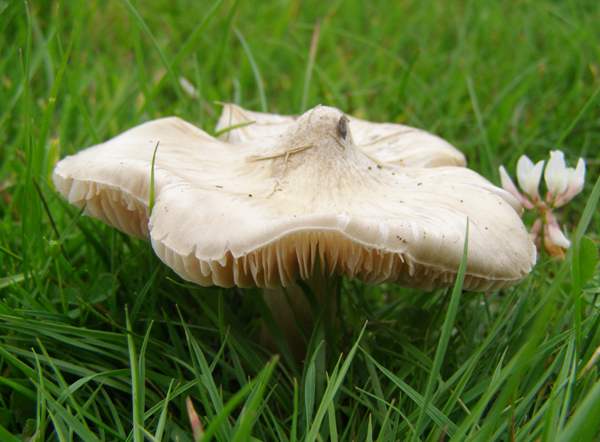
Often with a wavy margin and a small central umbo, the form of the grey-brown cap of this largish (for an Entoloma) mushroom is the source of its common name.
Unlike most grassland pinkgills, which generally appear in summer and autumn, the Shield Pinkgill is a mushroom of spring and early summer, and it is probably mycorrhizal with trees of the family Rosaceae, under which it is most often seen.
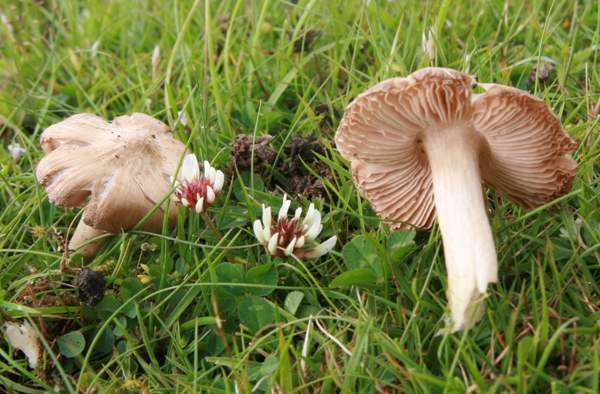
Distribution
This pinkgill mushroom is rarely seen in Wales but more commonly recorded in England and in some parts of Scotland. The Shield Pinkgill occurs fairly frequently also in most central and northern parts of mainland Europe and is recorded also from North America.
Taxonomic history
This impressive mushroom was described scientifically in 1753 by Carl Linnaeus, who gave it the name Agaricus clypeatus. (In those early days of fungal taxonomy most of the gilled mushrooms were included initially in the genus Agaricus!) It was the German mycologist Paul Kummer who, in 1871, transferred this species to its current genus, at which point its binomial scientific name became Entoloma clypeatum. Since then more than one form of this mushroom has been recognised, and so the formal name of the nominate (primary) form became Entoloma clypeatum f. clypeatum. (L.) P. Kumm.
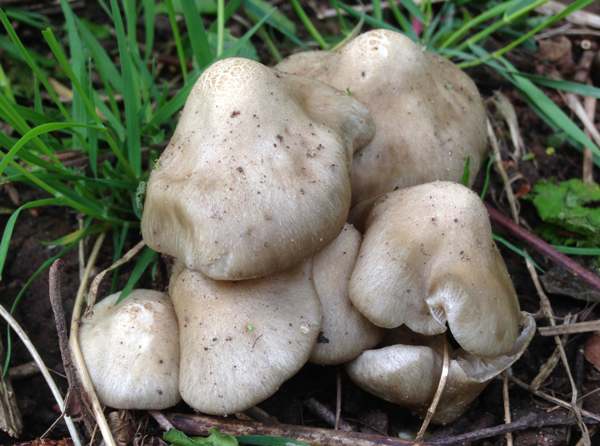
Synonyms of Entoloma clypeatum f. clypeatum include Agaricus clypeatus L., Agaricus fertilis Pers., Entoloma clypeatum (L.) P. Kumm., Entoloma clypeatum var. clypeatum (L.) P. Kumm., Entoloma fertile (Pers.) Gillet, and Rhodophyllus clypeatus (L.) Quél.
Entoloma clypeatum f. pallidogriseum Noordel. is a very rare pale grey form of the Shield Pinkgill, formally recorded from one site in England and one in southern Ireland but a little more common in some parts of mainland Europe.
Etymology
The generic name Entoloma comes from ancient Greek words entos, meaning inner, and lóma, meaning a fringe or a hem. It is a reference to the inrolled margins of many of the mushrooms in this genus.
The specific epithet clypeatum is Latin and means shaped like a round shield.
Identification guide
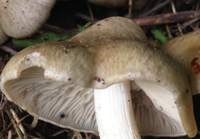 |
Cap3 to 10 cm across; initially convex, expanding to become broadly convex with a low umbo and occasionally a broad depression; various shades of grey-brown with darker brown radial fibrils; sometimes tinged yellow; hygrophanous, becoming much paler when dry; flesh thin, whitish and firm. |
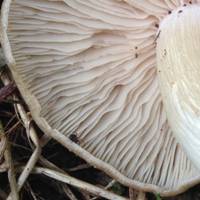 |
GillsAdnate; pale grey at first becoming pink and later a dirty brownish-pink at maturity. Stem3 to 5cm long and 8 to 15mm diameter; whitish with longitudinal silky brown fibrils, paler towards base; cylindrical, sometimes laterally compressed; no stem ring. |
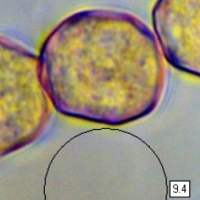 |
SporesAngular, pentagonal to heptagonal, 9-11 x 7.5-10µm. Spore printPink. |
Odour/taste |
Not distinctive. |
Habitat & Ecological role |
This saprobic pinkgill is fairly common under trees of the family Rosaceae in open woodlands and in parkland. |
Season |
Fruiting from spring to midsummer in Britain and Ireland. |
Similar species |
The Wood Pinkgill, Entoloma rhodopolium, can be similar in cap colour, although the surface is smooth and silky. |
Culinary Notes
Entoloma clypeatum is reported to be of 'suspect edibility', which I interpret to mean possibly poisonous. The Shield Pinkgill is quite similar in appearance to Entoloma species that are known to be seriously poisonous - for example Entoloma sinuatum, the Livid Pinkgill, which has caused the painful deaths of several people who have eaten it.
Reference Sources
Fascinated by Fungi, 2nd Edition, Pat O'Reilly 2016, reprinted by Coch-y-bonddu Books in 2022.
Studies in the genus Entoloma (Basidiomycota, Agaricales) from the Kiklades (C. Aegean, Greece), Machiel Noordeloos & Elias Polemis; Mycotaxon, Volume 105, pp. 301–312 July–September 2008.
Funga Nordica: 2nd edition 2012. Edited by Knudsen, H. & Vesterholt, J. ISBN 9788798396130
BMS List of English Names for Fungi
Dictionary of the Fungi; Paul M. Kirk, Paul F. Cannon, David W. Minter and J. A. Stalpers; CABI, 2008
Taxonomic history and synonym information on these pages is drawn from many sources but in particular from the British Mycological Society's GB Checklist of Fungi.
Acknowledgements
This page includes pictures kindly contributed by Simon Harding.
Fascinated by Fungi. Back by popular demand, Pat O'Reilly's best-selling 450-page hardback book is available now. The latest second edition was republished with a sparkling new cover design in September 2022 by Coch-y-Bonddu Books. Full details and copies are available from the publisher's online bookshop...
